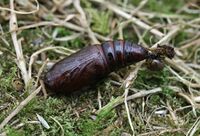Biology:Bright-line brown-eye
| Bright-line brown-eye | |
|---|---|

| |
| Scientific classification | |
| Domain: | Eukaryota |
| Kingdom: | Animalia |
| Phylum: | Arthropoda |
| Class: | Insecta |
| Order: | Lepidoptera |
| Superfamily: | Noctuoidea |
| Family: | Noctuidae |
| Genus: | Lacanobia |
| Species: | L. oleracea
|
| Binomial name | |
| Lacanobia oleracea (Linnaeus, 1758)
| |
The bright-line brown-eye (Lacanobia oleracea) is a moth of the family Noctuidae. The species was first described by Carl Linnaeus in his 1758 10th edition of Systema Naturae. It is a common species throughout Europe, but is also found in North Africa (Morocco and Algeria), temperate North Asia and Central Asia, Asia Minor, Syria, and Turkestan, northern India , China , Korea and Japan .
This species' common name is usefully descriptive: The forewings are dark reddish brown marked with a prominent light orange-brown stigma and a bright white subterminal line. The hindwings are grey, darker towards the termen. The wingspan is 34–44 mm. They are attracted to light, sugar and nectar-rich flowers.
Technical description and variation
Forewing red brown clouded with darker; veins grey, whitish towards termen: reniform stigma orange in its upper part, dark fuscous below; orbicular round, white edged, sometimes very small; submarginal line finely white, toothed on veins 3 and 4 to termen; hindwing dull whitish, pale fuscous towards termen; the veins dark. The ground colour varies on one side to black brown, ab. obscura Spul, and on the other to rufous, ab. rufa Tutt; ab. variegata Aust, from Morocco, is paler, reddish yellow.[1]
The larva is green or brown dotted with white with black and yellow spiracular lines down the side with darker edging. The tubercles are black. It feeds on a wide range of plants[2] and is occasionally a pest of cultivated tomatoes. The species overwinters as a pupa.
It is on wing from the latter half of June to July. Occasionally, there will be a second generation from the end of August to the first half of September.[3]
References
- ↑ Seitz, A. Ed., 1914 Die Großschmetterlinge der Erde, Verlag Alfred Kernen, Stuttgart Band 3: Abt. 1, Die Großschmetterlinge des palaearktischen Faunengebietes, Die palaearktischen eulenartigen Nachtfalter, 1914
- ↑ Robinson, Gaden S.; Ackery, Phillip R.; Kitching, Ian J.; Beccaloni, George W.; Hernández, Luis M. (2010). "Search the database - introduction and help". Natural History Museum, London. https://www.nhm.ac.uk/our-science/data/hostplants.
- ↑ Savela, Markku. "Lacanobia oleracea (Linnaeus, 1758)". https://www.nic.funet.fi/pub/sci/bio/life/insecta/lepidoptera/ditrysia/noctuoidea/noctuidae/hadeninae/lacanobia/#oleracea. Retrieved June 29, 2019.
Further reading
- Chinery, Michael (1986, reprinted 1991). Collins Guide to the Insects of Britain and Western Europe
- Skinner, Bernard (1984). The Colour Identification Guide to Moths of the British Isles
External links
- Kimber, Ian. "73.267 BF2160 Bright-line Brown-eye Lacanobia oleracea (Linnaeus, 1758)". https://www.ukmoths.org.uk/species/lacanobia-oleracea/. Retrieved 29 June 2019.
- Savela, Markku. "Lacanobia oleracea (Linnaeus, 1758)". https://www.nic.funet.fi/pub/sci/bio/life/insecta/lepidoptera/ditrysia/noctuoidea/noctuidae/hadeninae/lacanobia/#oleracea. Retrieved June 29, 2019. Taxonomy
- Lepiforum e.V.
- De Vlinderstichting (in Dutch)
Wikidata ☰ Q769896 entry
 |



